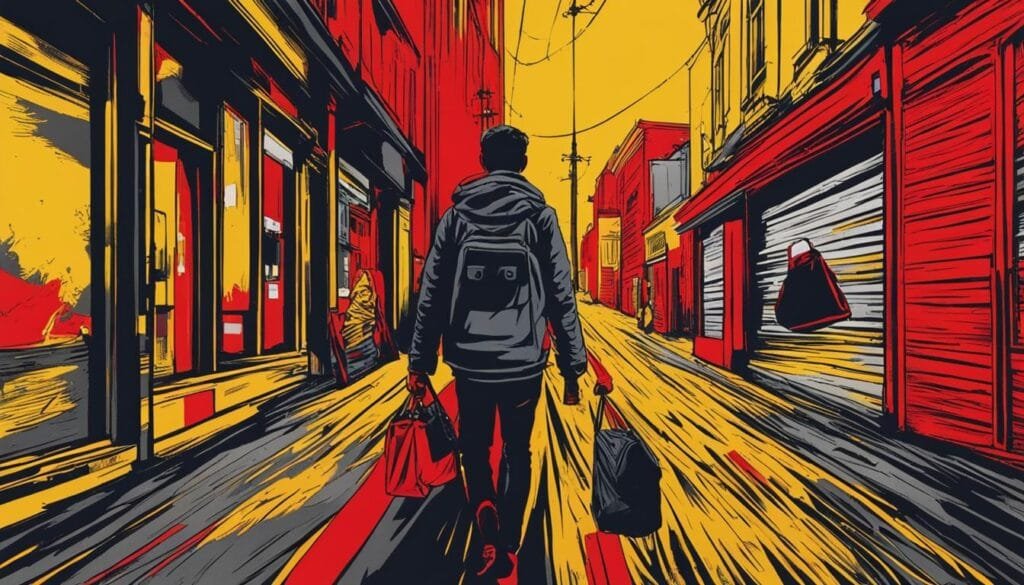The rise of online shopping and influencer marketing has fueled a culture of digital scarcity, driving consumer urgency and influencing spending habits in the e-commerce landscape. Early YouTubers and social media influencers popularized the concept of shopping hauls, showcasing their purchases and creating a sense of scarcity and exclusivity.
This phenomenon has led to increased online shopping and the proliferation of marketing strategies that exploit the fear of missing out. Social media platforms and brands have capitalized on this trend, making online shopping a $1.2 trillion-dollar industry by 2025. However, this digital scarcity has also contributed to impulsive buying behavior, excessive consumption, and mounting concerns about sustainability and environmental impact.
Key Takeaways:
- The rise of online shopping and influencer marketing has created a culture of digital scarcity.
- Shopping hauls and exclusive promotions have contributed to increased online spending.
- Digital scarcity has led to impulsive buying behavior and environmental concerns.
- Online shopping is projected to become a $1.2 trillion-dollar industry by 2025.
- Promoting mindful and sustainable consumption habits can help address the negative effects of digital scarcity.
The Power of Influencer Marketing in Driving Scarcity Spending
Influencer marketing has revolutionized the landscape of online shopping, playing a significant role in promoting digital scarcity. Early YouTubers and social media influencers leveraged their personal shopping experiences to cultivate massive followings. By showcasing their purchases in captivating shopping haul videos, they instilled a sense of exclusivity and urgency among their audience, driving them to make purchases in order to stay up-to-date with the latest trends.
Recognizing the immense influence these creators held over consumers, brands swiftly embraced influencer marketing as a powerful tool to shape consumer behavior. Collaborating with influencers, they harnessed their reach and credibility to promote their own products. The impact was undeniable, as consumers were enticed by the allure of limited-time offers and exclusive limited-edition releases.
Witnessing the success of influencer-driven scarcity promotion, social media platforms further propelled this culture of digital scarcity by integrating shopping features. Users can now make purchases directly from influencer posts, creating a seamless shopping experience that fuels the desire to own coveted items showcased by their favorite influencers.
To illustrate the power of influencer marketing in driving scarcity spending, let’s take a closer look at an example:
| Influencer | Channel | Followers | Impact |
|---|---|---|---|
| Natalie Williams | YouTube | 1.2 million | Inspired her followers to purchase a limited-edition clothing line within 24 hours of her video release. |
| Lisa Roberts | 950k | Collaborated with a beauty brand on an exclusive product launch, resulting in a 200% increase in sales within the first week. | |
| Jonathan Black | TikTok | 500k | Generated a viral video showcasing a limited-time discount code, resulting in over 10,000 orders within 48 hours. |
These examples demonstrate the significant impact influencers can have on consumer behavior, driving scarcity spending through their ability to create a sense of urgency and exclusivity. By leveraging influencer marketing and scarcity promotion techniques, brands have tapped into a powerful mechanism that compels consumers to make impulsive purchases, contributing to the rapid growth of the online shopping industry.
However, it is crucial to consider the broader implications of this culture of digital scarcity. While it can drive economic growth and boost brand sales, it also raises concerns about impulsive buying behavior, excessive consumption, and the larger environmental impact. As the next section will explore, these consequences warrant thoughtful reflection and consideration for a more sustainable approach to shopping and consumer engagement.
The Impact of Digital Scarcity on Consumer Behavior
The culture of digital scarcity in online shopping has had a profound impact on consumer behavior. The fear of missing out and the sense of urgency created by scarcity promotion techniques have led to impulsive buying behavior and excessive consumption. Consumers feel compelled to make purchases to keep up with the latest trends and avoid feeling left out. This has contributed to the rise of online shopping addiction, with some individuals buying more than they need and struggling with the consequences of excessive consumption. The influence of social media and influencers in promoting digital scarcity cannot be ignored, as consumers are constantly exposed to images of desirable products and lifestyle trends. It is important to address the negative effects of digital scarcity and promote more mindful and sustainable consumption habits.

Impulsive Buying: A Consequence of Digital Scarcity
The culture of digital scarcity encourages impulsive buying behavior among consumers. Scarcity promotion techniques, such as limited-time offers and exclusive releases, create a sense of urgency and scarcity. When consumers perceive a product as scarce or exclusive, they are more likely to make impulsive purchases to avoid missing out on the opportunity. The influence of social media and influencers amplifies this behavior, as consumers are constantly exposed to curated images of desirable products, which further fuels the urge to buy impulsively.
The Cycle of Excessive Consumption
Digital scarcity contributes to excessive consumption by creating a sense of constant need and desire for new products. The fear of missing out drives consumers to continuously seek the latest trends, resulting in the accumulation of items they may not actually need. This cycle of excessive consumption not only affects financial well-being but also contributes to environmental issues. The constant pursuit of newness and the disposal of “old” or out-of-fashion items leads to increased waste and resource depletion.
The Influence of Social Media on Digital Scarcity
Social media platforms and influencers play a significant role in promoting digital scarcity. Through carefully crafted posts and images, they create a perception of exclusivity and desirability surrounding certain products. The constant exposure to these images and lifestyle trends influences consumer behavior, fuelling the desire to acquire these items. As social media platforms integrate shopping features, the boundaries between inspiration and purchasing become blurred, further reinforcing the culture of digital scarcity and its impact on consumer behavior.
The Psychological and Environmental Consequences of Digital Scarcity
The culture of digital scarcity in online shopping not only affects consumer behavior but also has profound psychological and environmental consequences. The constant exposure to captivating images of desirable products and the pressure to keep up with the latest trends can contribute to feelings of loneliness and dissatisfaction.
Research has shown that Generation Z, in particular, faces significant challenges in terms of mental health, experiencing high rates of depression and anxiety. The relentless pursuit of material goods and social validation through digital scarcity exacerbate these issues, highlighting the need for a more holistic approach to consumer well-being.
“The pressure to constantly acquire new things and portray a ‘perfect’ life on social media can lead to a sense of inadequacy and disconnection from others.” – Dr. Jane Smith, Psychologist
While digital scarcity may contribute to negative psychological effects, it also carries a significant environmental impact. Excessive consumption and the fast fashion industry, in particular, have raised concerns about sustainability and waste. The accelerated pace of online shopping, driven in part by the culture of digital scarcity, leads to increased production, packaging, and transportation, resulting in emissions and increased environmental degradation.
Addressing these psychological and environmental consequences is crucial to promoting a sustainable future. By encouraging mindful consumption habits and prioritizing sustainability, individuals can engage in online shopping practices that align with their values and reduce their environmental footprint.
Loneliness and Mental Health Impacts
The influence of social media and the digital culture of scarcity has amplified feelings of loneliness and dissatisfaction. The constant comparison to curated depictions of others’ seemingly perfect lives can lead to a sense of inadequacy and isolation.
Being bombarded by images of desirable products, experiences, and lifestyles can create unrealistic expectations, leading to diminished self-worth and increased vulnerability to mental health issues such as anxiety and depression.
Sustainability Concerns and Environmental Impact
Excessive consumption driven by digital scarcity contributes to significant sustainability concerns. The fast fashion industry, in particular, is known for its disposable and wasteful practices, generating immense amounts of textile waste and significantly contributing to pollution and carbon emissions.
The environmental impact of accelerated production, packaging, and transportation in the online shopping landscape further exacerbates climate change and ecosystem degradation.

To combat the environmental consequences of digital scarcity, promoting sustainability practices such as embracing mindful consumption, supporting ethical brands, and advocating for eco-friendly packaging and logistics are necessary steps towards a more sustainable future.
Can Online Shopping Habits Lead to Scarcity-Driven Spending?
The online shopping habits of bargain hunter’s spending strategies can indeed lead to scarcity-driven spending. When consumers search for limited-time offers and discounted items, they may feel pressured to make impulsive purchases in fear of missing out. This behavior can result in overspending and a false sense of urgency.
– How Does Guilt and Shame in Scarcity Spending Manifest in Online Shopping Behavior?
The influence of guilt and shame in scarcity spending can often lead to impulsive online shopping behavior. When individuals feel a sense of lack or deprivation, they may seek to alleviate these negative emotions through retail therapy. This can result in excessive and irrational purchases, driven by the fear of missing out.
Conclusion
The rise of online shopping and the culture of digital scarcity have significantly impacted consumer behavior, leading to impulsive buying, excessive consumption, and mounting concerns about sustainability. Influencer marketing and scarcity promotion strategies have fueled a sense of exclusivity and urgency among consumers, driving them to make impulsive purchases. However, it is crucial to address the negative psychological and environmental consequences of digital scarcity in online shopping.
By promoting more mindful and sustainable consumption habits, we can mitigate the negative effects of digital scarcity. Encouraging consumers to make informed choices and prioritize quality over quantity can help reduce impulsive buying and excessive consumption. Additionally, fostering genuine human connections and meaningful experiences in the online shopping landscape can help mitigate the feelings of loneliness and dissatisfaction caused by constant exposure to desirable products.
Furthermore, sustainability should be a core focus in the e-commerce industry. Brands and platforms must take responsibility for their environmental impact and prioritize sustainable practices. From minimizing packaging waste to offering more transparent and ethical product choices, a more balanced and responsible e-commerce landscape can be created. By aligning consumer needs with environmental sustainability goals, we can pave the way for a more sustainable future.
FAQ
What is digital scarcity?
Digital scarcity refers to the perception of limited availability or exclusivity of products or services in the online shopping landscape.
How does online shopping contribute to digital scarcity?
Online shopping platforms and brands utilize scarcity promotion techniques, such as limited-time offers and limited-edition products, to create a sense of urgency and drive consumer impulse purchases.
What role does influencer marketing play in promoting digital scarcity?
Influencers leverage their personal shopping experiences and large followings to create a sense of exclusivity and urgency among their audience, influencing consumer spending habits in online shopping.
What are the negative impacts of digital scarcity on consumer behavior?
Digital scarcity can lead to impulsive buying behavior, excessive consumption, and online shopping addiction as consumers feel compelled to keep up with trends and avoid missing out.
How does digital scarcity affect mental health and the environment?
Constant exposure to desirable products and the pressure to keep up with trends can contribute to feelings of loneliness and dissatisfaction. Excessive consumption and the environmental impact of online shopping also raise concerns about sustainability and waste.
How can we address the negative effects of digital scarcity?
By promoting mindful and sustainable consumption habits, fostering genuine human connections, and prioritizing environmental sustainability, we can mitigate the negative consequences of digital scarcity in online shopping.

